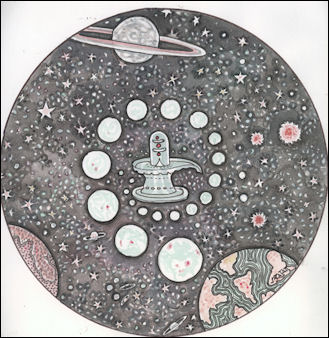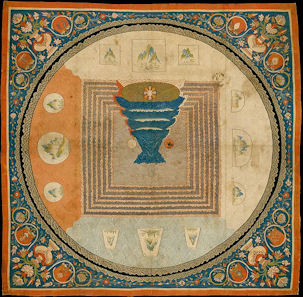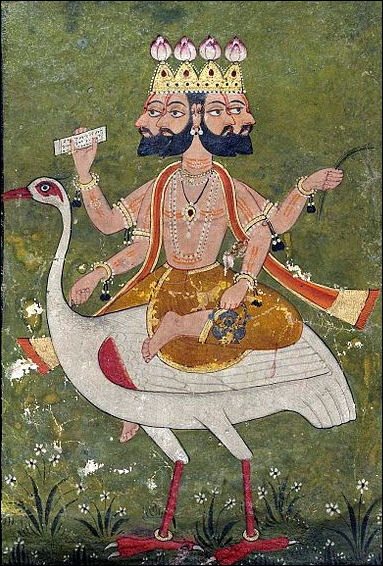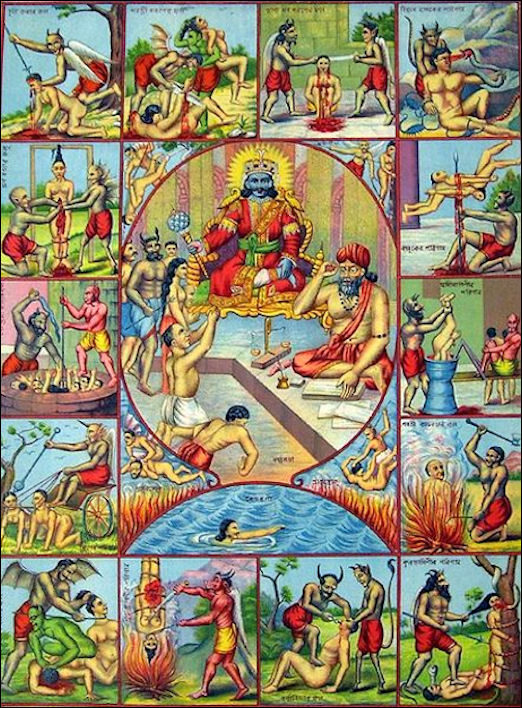HINDU UNIVERSE AND CREATION

The Hindu universe is much larger and multidimensional that the Christian one. It is conceived as an egg with 21 different zones (made up of six heavens, one earth, seven netherworlds and seven hells) or a mandala with a square divided into a number of small squares around the Supreme Deity, which is the source of all existence and has been compared to a radioactive spider at the center of a web emitting energy that is absorbed by all other objects in the universe.
Western religion has traditionally divided the world into the mortal and non-mortal with a clear time line to the future or the past. Hindus see many more possibilities. According to Hindu philosophy the universe is eternal but always changing. Everything is continually being born, growing and dying and being reborn. All matter is composed of five basic elements: earth, fire, water, space and sky. Humans are part of nature and susceptible to the same rules as everything else. The thing that separates humans from animals is their sense of inner consciousness, and the ability to understand the cosmos.
"For the Hindu," the historian Daniel Boorstin wrote, "the creation was not a bringing into being of the wonder of the world. Rather it was dismemberment, a disintegration of the original Oneness. For him the Creation seemed not the expression of a rational benevolent Maker in wondrous new forms but a fragmenting of the unity of nature into countless limited forms...For the Hindu our very notion of creation was reversed. Instead of transforming nothing into everything the Hindu creation broke into countless imperfect fragments what was already there." [Source: Daniel Boorstin, "The Discoverers"]
The Vedas do not say much about a Creator or Creation. In one story the universe was prepared by a primeval Lord of Beings named Prajapati, who was sacrificed before the universe was created. How he was created and who sacrificed him is not clear. In the Upanishads the original human is an Adam-like man who asks for company and then is pleased when a female is made from his body.
Websites and Resources on Hinduism: Hinduism Today hinduismtoday.com ; India Divine indiadivine.org ; Wikipedia article Wikipedia ; Oxford center of Hindu Studies ochs.org.uk ; Hindu Website hinduwebsite.com/hinduindex ; Hindu Gallery hindugallery.com ; Encyclopædia Britannica Online article britannica.com ; International Encyclopedia of Philosophy iep.utm.edu/hindu ; The Hindu Religion, Swami Vivekananda (1894), .wikisource.org ; Journal of Hindu Studies, Oxford University Press academic.oup.com/jhs
Creation of the World According to the Upanishads

Cosmological Mandala with Mount Meru Creation of the World According to the Upanishads: 1) There was nothing whatsoever here in the beginning. By death indeed was this covered, or by hunger, for hunger is death. He created the mind, thinking 'let me have a self' (mind). Then he moved about, worshiping. From him, thus worshiping, water was produced. . . .
2 . . . .. That which was the froth of the water became solidified; that became the earth. On it he [i.e., death] rested. From him thus rested and heated (from the practice of austerity) his essence of brightness came forth (as) fire.
3) He divided himself threefold (fire is one-third), the sun one-third and the air one-third. He also is life [lit., breath] divided threefold, . . . (Brihad-aranyaka Upanishad, 1, 2, 1-3.) [Source: S. Radhakrishnan (editor and translator), “The Principal Upanishads” (New York: Harper & Row, 1953), PP. 151-2, 399, 447-9,, Eliade Page website]
1) The Sun is Brahman-this is the teaching. An explanation .thereof (is this). In the beginning this (world) was non-existent. It became existent. It grew. It turned into an egg. It lay for the period of a year. It burst open. Then came out of the eggshell, two parts, one of silver, the other of gold. That which was of silver is this earth; that which was of gold is the sky. What was the outer membrane is the mountains; that which was the inner membrane is the mist with the clouds. What were the veins were the rivers. What was the fluid within is the ocean. (Chandogya Upanishad, III, 19, 1-2.)
The sage Uddalaka presents another view: in the beginning was Being alone: 1 In the beginning, my dear, this was Being alone' one only
without a second. Some people say 'in the beginning this Was non-
being alone, one only; without a second. From that non-being, being
was produced.'
2) But how, indeed, my dear, could it be thus? said he [i.e., the
sage Uddalaka], how could being be produced from non-being? On the
contrary, my dear, in the beginning this was being alone, one only,
without a second.
3) It thought, May I be many, may I grow forth. It sent forth fire.
That fire thought, May I be many, may I grow forth. It sent forth water. . . .
4) That water thought, May I be many, may I grow forth. It sent forth food. . . .
(Chandogya Upanishad, VI, 2, 1-4.)
Creation in the Rig Veda
In the “Hymn of Creation” the Brahma poets in the Rig-Veda raised doubts about how and what occurred at creation could ever be known:

“But, after all, who knows, and who can say
whence it all came, and how creation happened?
The gods themselves are later than creation.
so who knows truly whence it has arisen?
Whence all creation had its origin.
he, whether he fashioned it to whether he did not.
he, who surveys it all from the highest heaven.
he knows?or maybe even he does not know.”
The “Hymn of the Primeval Man” tells how the castes were created before the heavens:
“When they divided the Man
into many part did they divide him?
What was his mouth, what were his arms.
what were his feet and feet called?
The Brahma was his mouth
of his arms was made the warrior
His thighs became the Vaisya.
of his feet the Sudra was born
The moon arose from his mind
from his eye was born the sun
from his mouth Indra and Agni
from his breath the wind was born.
From his navel came the air.
from his head there came the sky
from his feet the earth, the 4 quarters from his ear.
thus they fashioned the worlds.
With sacrifice the gods sacrificed to Sacrifice
these were the first of the sacred laws.
These mighty beings reached the sky.
where the eternal spirits, the gods. “
Creation of Self, Women, Cows and Animals
According to the Hindu creation myth, at the beginning of time, Self (“Atman” ) sat alone. Looking around and seeing only himself, he said, "This is I" (That is why even today men and women identify themselves first as "I"). Since the Self had incinerated all the evil that had existed before, he therefore was a person (“purusha” ). When faced with the thought of loneliness, Self said, "As there is nothing but myself, why should I fear?" [Source: Brihadaranyaka Upanishad]
With his fear gone, Self realized that a lonely man can feel no delight. Since he was as large as a man and woman together he divided himself in two and created his wife Yagnavalkya, who said after coming into being, "We two are thus (each of us) like half a shell." In the great void Self embraced his wife and men were born. [Ibid]
Afterwards Yagnavalkya said, "How can he embrace me after having produced me from himself. I shall hide myself." She then turned herself into a cow. Self then became a bull and embraced her, hence cows were born. She then became a mare and he stallion, producing horses. Asses, goats and sheep were created in a similar fashion, and so it went until all the members of the animal kingdom were created, even ants. [Ibid]
Hindu Cosmology Cycles
Hindus and Buddhist view life and time in a cosmological sense as an "unending universe of unending cycles." They generally do not have end of the world scenarios. Even creation is seen as something that occurs again and again. By contrast Jews, Christians and Muslims all have end of the world scenarios, foretold by natural disasters and other calamities, that feature the accession to heaven by the faithful. “Cosmos”, incidently, is a Sanskrit word for justice.
The basic cycle in Hindu time is a “kalpa” “a “day” in the life of Brahma. Each kalpa lasts 4.32 billion earth years. A “night of Brahma'”lasts the same amount of time. A “year of Brahma” is comprised 360 such days and nights, and Brahma lives for one hundred such years. Each kalpa marks another Re-creation of the world. During each kalpa-night the universe is once again gathered up into Brahma's body, where it becomes “the possibility of still another Creation on the next day."
Each cycle begins with Vishnu lying asleep on the thousand-headed cobra “Sesha”. From his naval grows a lotus that give birth to Brahma, who creates the universe. Vishnu awakes and governs over the kalpa, which ends when he goes back to sleep and the universe once again is sucked into his body.
Each “kalpa” contains fourteen smaller cycles, “manvantara” , each of which lasts for 306,720,000 years Within each of these cycles a new Manu, or presiding god, is created and he in turn re-creates the human race. Within each “manvantaras” , there are seventy-one aeons or “mahayugas”, a thousand of which comprise a kalpa. Within each “mahayuga” there is a cycle of four “yugas” , each of which is a different age of the world, including in turn 4,800, 3,600, 2,400 and 1,200 'years.' Each of the four yugas shows a decline in civilization and morality from the “yuga” just before, until finally the world is destroyed by flood and fire to be prepared for yet another cycle of Creation. [Source: Daniel Boorstin, "The Discoverers"]
Change on earth is slower than man can grasp. We are currently in the Kali Yuga, the last, darkest and most miserable cycle in Hindu cosmology. This cycle is said to have begin with the battle described in the “Bhagavad Gita” . Following it will be a period of light, expressed in the 1960s as the Age of Aquarius.
Hindu Heaven and Hell
Hindus believe that all living creatures — from bacteria to blue whales, and even some plants — have souls, which are essentially equal, and all these life forms are manifestations of the unity of the universe. This is why Hindus are vegetarians and abhor killing animals; and “ahimsa” , the belief that it is a sin to harm any living creature, is an important precept in Hinduism. The concept was eluded to in the Upanishads and contrasts sharply with doctrines of Western religions which holds that mankind is a special creation on a plane higher than other creatures.

Kailash, Mt. MeruLife and death are seen as meaningless cycles. Life itself is often characterized as a dream that has little to with relevance of the true nature of things in terms of the universe, cosmology and forces behind life. Reality is like an onion whose successive layers have to be pealed to reveal the universe eternal truth. On this subject Krishna told Arjuna in the Bhagavad Gita:
“Do not say
God gave us this delusion.”
You dream you are a doer.
You dream that action is done.
You dream that action bears fruit.
It is your ignorance.
It is your delusion
That gives these dreams.”
Hindus believe in “Paramatman” (the eternal, blissful self), which contradicts the Buddhist belief in the impermanent and transitory nature of things.
Mt. Meru
Reincarnation is the transmigration of the soul from one life form to another. It doesn’t just apply to humans but to all creatures and some non-living things too. Transmigration of the soul can take place from a human or creature into another human or creature up or down a scale based on good and evil deeds (See Karma Below). If a person has lived a virtuous life he moves up the scale, say, from a low caste to a high caste. If a person has lived an unworthy life he moves down the scale, say, from a low caste to a rat.
Reincarnation is a belief found in most Asian religions and is a cornerstone of all the major religions found in India except Islam. The Hindu idea of reincarnation is roughly the same regardless of which Hindu god an individual venerates most.
The Hindu concept of reincarnation first appeared in the Upanishads and is believed to have originated in the Ganges Plain and was absorbed b the Aryan-centered Hinduism as the Aryans moved into the Ganges Plain. Beliefs in reincarnation are not just found in India and Asia but are found in tribal cultures all over the world and were held by the ancient Greeks, Vikings and other groups in the West. Ideas about reincarnation are probably very old and were held by people who lived in Neolithic times.

Yama and Hindu hell
Image Sources: Wikimedia Commons
Text Sources: “World Religions” edited by Geoffrey Parrinder (Facts on File Publications, New York); “Encyclopedia of the World’s Religions” edited by R.C. Zaehner (Barnes & Noble Books, 1959); “Encyclopedia of the World Cultures: Volume 3 South Asia “ edited by David Levinson (G.K. Hall & Company, New York, 1994); “The Creators” by Daniel Boorstin; “A Guide to Angkor: an Introduction to the Temples” by Dawn Rooney (Asia Book) for Information on temples and architecture. National Geographic, the New York Times, Washington Post, Los Angeles Times, Smithsonian magazine, Times of London, The New Yorker, Time, Newsweek, Reuters, AP, AFP, Lonely Planet Guides, Compton’s Encyclopedia and various books and other publications.
Last updated December 2023
